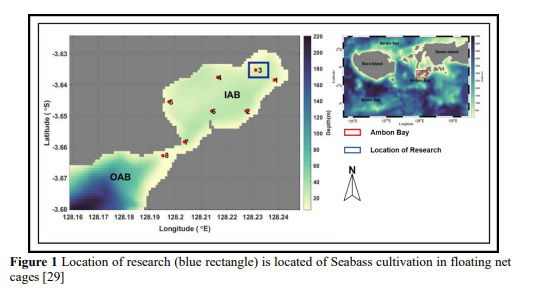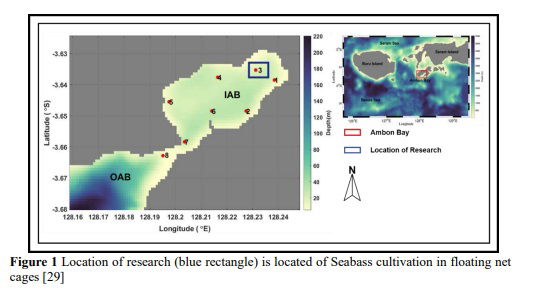The Growth Rate of Seabass in Floating Net Cages, Inner Ambon Bay using 1D Ecosystem Model

Abstract.
Inner Ambon Bay is used for fishery research by the government. One of the species that has been cultivated is seabass because it has high economic value. Seabass cultivation in floating net cages has been developed by Ambon Marine Aquaculture Institute (BPBL-Ambon). The characteristics of seawater in Inner Ambon Bay (IAB) based on the observation data in the project “Ocean Current System of Indonesia Waters and Its Effect on Marine Fisheries Production” in May 2017 show that the temperature is in the range 29.8 – 30.9 °C. Meanwhile the salinity is about 26.1 – 31.4 PSU and the chlorophyll concentrations as much as 0.88 – 3.61 mg/m3 . The 1D ecosystem model simulation is performed to know how is the growth rate of seabass is with two-way interaction between nutrient, phytoplankton, zooplankton, and detritus (NPZD) towards zooplanktontivor (fishes which consume zooplankton). The verification of model result (fish mass) with the observation data of fish mass which conduct by BPBL Ambon show the RMSE value is 0.001 kg and the correlation is 0.99. The nutrient concentration since 2016 – 2018 in the range of 3.08 – 3.78 mmolC/m3 . While the phytoplankton, zooplankton, and detritus concentration during 3 years each one is 4.67 – 5.84, 11.53 – 15.77, and 16.88 – 20.67 mmolC/m3 . The fastest growth rate of Seabass with the first scenario is 1.52 grams/day with the duration of 257 days and when the juvenile of seabass spread in January. The fastest growth rate of Seabass with addition feed is 2,23 grams/day during 175 days.
1. Introduction
Ambon Bay is divided by Inner Ambon Bay (IAB) and Outer Ambon Bay (OAB). IAB is the center for cultivation development which managed by Ambon Marine Aquaculture Institute or Balai Perikanan Budidaya Laut (BPBL-Ambon). There are many species of fishes such as Grouper, Pomfret, Seabass, shrimp, and other fishes [1]. Seabass is one of the leading commodities which has high economical because disease resistant, fast growth rate, and easy nursing [2]. Seabass or Barramundi (Lates calcarifer) is one of the big demersal that live in the bottom of waters [3]. It can live in the sea which has width salinity range or we can also call euryhaline [4]. Barramundi or Seabass is catadromous [5] which spawn in the sea then grow to maturity in the river [6]. Thus, seabass can be cultivated in fresh water and saline water [7]. Seabass is found in the waters north Java, eastern Sumatra, Kalimantan, South Sulawesi, Tiworu Strait, and Arafura [8]. It can grow up to 3 – 5 kg in weight [9] with a life period of 2 – 3 years [10]. Seabass is also a protandrous hermaphrodite fish [11] that is able to change male sex to female [12].

